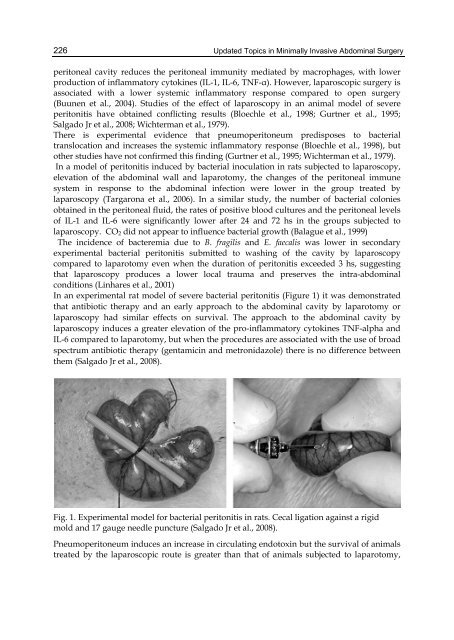UPDATED TOPICS IN MINIMALLY INVASIVE ABDOMINAL SURGERY
UPDATED TOPICS IN MINIMALLY INVASIVE ABDOMINAL SURGERY
UPDATED TOPICS IN MINIMALLY INVASIVE ABDOMINAL SURGERY
Create successful ePaper yourself
Turn your PDF publications into a flip-book with our unique Google optimized e-Paper software.
226<br />
Updated Topics in Minimally Invasive Abdominal Surgery<br />
peritoneal cavity reduces the peritoneal immunity mediated by macrophages, with lower<br />
production of inflammatory cytokines (IL-1, IL-6, TNF-α). However, laparoscopic surgery is<br />
associated with a lower systemic inflammatory response compared to open surgery<br />
(Buunen et al., 2004). Studies of the effect of laparoscopy in an animal model of severe<br />
peritonitis have obtained conflicting results (Bloechle et al., 1998; Gurtner et al., 1995;<br />
Salgado Jr et al., 2008; Wichterman et al., 1979).<br />
There is experimental evidence that pneumoperitoneum predisposes to bacterial<br />
translocation and increases the systemic inflammatory response (Bloechle et al., 1998), but<br />
other studies have not confirmed this finding (Gurtner et al., 1995; Wichterman et al., 1979).<br />
In a model of peritonitis induced by bacterial inoculation in rats subjected to laparoscopy,<br />
elevation of the abdominal wall and laparotomy, the changes of the peritoneal immune<br />
system in response to the abdominal infection were lower in the group treated by<br />
laparoscopy (Targarona et al., 2006). In a similar study, the number of bacterial colonies<br />
obtained in the peritoneal fluid, the rates of positive blood cultures and the peritoneal levels<br />
of IL-1 and IL-6 were significantly lower after 24 and 72 hs in the groups subjected to<br />
laparoscopy. CO2 did not appear to influence bacterial growth (Balague et al., 1999)<br />
The incidence of bacteremia due to B. fragilis and E. faecalis was lower in secondary<br />
experimental bacterial peritonitis submitted to washing of the cavity by laparoscopy<br />
compared to laparotomy even when the duration of peritonitis exceeded 3 hs, suggesting<br />
that laparoscopy produces a lower local trauma and preserves the intra-abdominal<br />
conditions (Linhares et al., 2001)<br />
In an experimental rat model of severe bacterial peritonitis (Figure 1) it was demonstrated<br />
that antibiotic therapy and an early approach to the abdominal cavity by laparotomy or<br />
laparoscopy had similar effects on survival. The approach to the abdominal cavity by<br />
laparoscopy induces a greater elevation of the pro-inflammatory cytokines TNF-alpha and<br />
IL-6 compared to laparotomy, but when the procedures are associated with the use of broad<br />
spectrum antibiotic therapy (gentamicin and metronidazole) there is no difference between<br />
them (Salgado Jr et al., 2008).<br />
Fig. 1. Experimental model for bacterial peritonitis in rats. Cecal ligation against a rigid<br />
mold and 17 gauge needle puncture (Salgado Jr et al., 2008).<br />
Pneumoperitoneum induces an increase in circulating endotoxin but the survival of animals<br />
treated by the laparoscopic route is greater than that of animals subjected to laparotomy,














![focuspdca.ppt [Compatibility Mode]](https://img.yumpu.com/22859457/1/190x146/focuspdcappt-compatibility-mode.jpg?quality=85)


